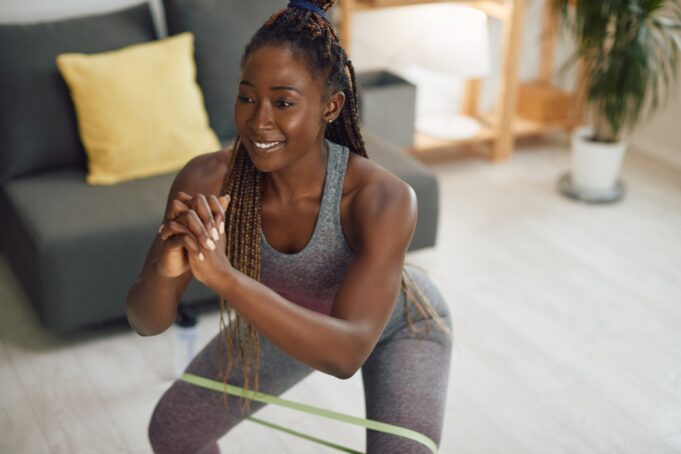Two years ago, working out at home was the only option for many people who wanted to start or maintain exercise plans in the early days of the pandemic. While gyms and fitness classes have long since resumed and relaxed COVID-19 protocols have prompted some people to feel more comfortable exercising with others, working out at home still has its advantages.
The biggest of those might be time management. “One of the hardest parts about working out is getting to the gym,” says L.A.-based personal trainer Joshua Shibata. “There’s a lack of motivation there and, if it takes you a while to get to the gym, because of traffic or distance, that motivation is even harder to get. It’s a little bit easier if you’re at home and the gym’s right there.”
Working out at home can also be a budget-friendlier approach to making exercise part of your routine. There are plenty of videos online that can guide you through cardio, flexibility and toning routines that require little-to-no equipment. Plus, basic gear — yoga mats, small weights and resistance bands amongst them — can be found through many different retailers at various price points.
You don’t necessarily need a lot of room for at-home fitness either. As long as you can move around comfortably and safely, you’re good. However, there is a catch. If you want to designate a space for fitness that doesn’t overwhelm your home or your budget, you’ll need to make plans. Here’s what you should do.
Create an exercise plan
Before you create a fitness space at home, you need to have a clear picture of your interests and goals. Are you using YouTube videos and focusing on dance-based cardio? Then you might need a little more space and require less equipment than you would if you’re focusing on building strength and musculature with a trainer via Zoom.
“We all have different goals, so you have to adjust your workout plan accordingly. Therefore, you also have to have the right tools for your workout plan and goal,” says Shibata. “Make sure that you find out what you want to do, then start finding the pieces that you want to buy.”
Designate a space
You don’t need much space to get in a workout at home, but you will need to carve out a space that allows you to move safely and without interruption. Depending on your fitness goals, this area can take different shapes.
When it comes to Pilates, says Marisol Reed, a San Fernando Valley-based personal trainer who works with clients over Zoom, you’ll need enough room for a yoga mat. If possible, Reed has her clients set up near a door knob, which she’ll guide them to use with bands to mimic the movements that they might ordinarily do on a reformer. If you’re doing a virtual session, you will need to also position your laptop to give your instructor a clear view. “I prefer if they have it further away so that I can see their whole bodies,” says Reed. “I need to be able to see them; otherwise, I don’t know if they’re lifting their leg the right way or if they’re moving too much.”
For cardio, you might need more room to move. Shibata suggests that you avoid working out under a ceiling fan or any kind of hanging fixture, particularly if your routine includes movements where you’ll be raising your arms over your head.
“Be careful or mindful of the surrounding area,” he says.
Buy only what you need
“I think that the biggest problem that a lot of people have is that they just buy a lot of stuff because that’s what they see at their local gym,” says Shibata. “If you’re not focusing on building a lot of muscle, there’s really no reason to buy a 50-pound set of dumbbells.”
If you work out with a trainer, ask them what they think the best equipment would be for your goals. Take into consideration, too, how much storage space you have.
One item you’ll likely need is a yoga mat, which can be used for a lot more than just sun salutations. Shibata points out that a mat can help protect hardwood floors if you drop a weight. Similarly, a mat can help protect you if you’re exercising on carpet. “If you’re doing something like mountain climbers, where you’ve really got to move your feet back and forth across the ground, carpet will definitely burn,” he explains.
If you use workout videos, you’ve probably heard about or seen common household items that can be substituted for some pieces of gear. Books can take the place of yoga blocks. Chairs can stand in for barres when you need a little help with balance. Search online and you’ll find tutorials on how you can use water bottles as weights too.
Keep your gear close
Once you’ve designated a workout space and collected your gear, it’s time to make sure things are organized. Keep your tools in the same space where you plan to use them. Reed suggests using a basket that you can keep near you while you’re exercising. This will help save time between specific movements, which, she points out, is important in Pilates as lost time can cause you to lose momentum.
“You don’t want to have to stop and then let your body relax and then have to build back up into it,” she says. “If that ball is right there, or that foam roller, or the bands are right there, then we can keep the muscles engaged.”
When you’re done, return your gear to the basket and tuck it into a corner, or place it on a shelf, where you will easily find everything. You don’t want to spend too much time looking for your weights or resistance band before your next session.











